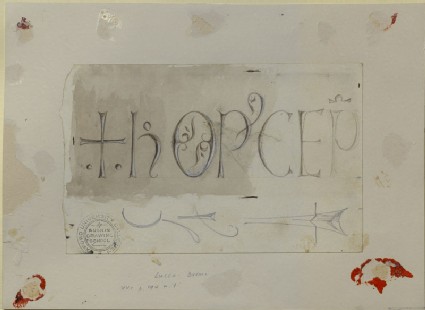Browse: 1470 objects
- Reference URL
Actions
An engraved Inscription from the Duomo of Lucca John Ruskin
-
Details
- Artist/maker
-
John Ruskin (1819 - 1900)
- Object type
- drawing
- Material and technique
- watercolour, bodycolour and ink over graphite on wove paper
- Dimensions
- 133 x 212 mm (drawing); 216 x 295 mm (mount)
- Associated place
-
- Europe › Italy › Toscana (Tuscany) › Lucca › Lucca › Lucca Duomo › Lucca Duomo (subject)
- Inscription
- Recto, bottom left, the Ruskin School's stamp
On the front of the mount, below the drawing, left of centre, in graphite (recent): Lucca - Duomo | XXI p. 194 n. 1
On the back of the mount:
right of centre, in ink: M. 21
just above, the Ruskin School's stamp
above and to the right, in graphite: R.90
- Provenance
-
Presumably presented by John Ruskin to the Ruskin Drawing School (University of Oxford); first recorded in the Ruskin Drawing School in 1878; transferred from the Ruskin Drawing School to the Ashmolean Museum c.1949
- No. of items
- 1
- Accession no.
- WA.RS.RUD.090bis
-
Subject terms allocated by curators:
Subjects
-
References in which this object is cited include:
References
Taylor, Gerald, ‘John Ruskin: A Catalogue of Drawings by John Ruskin in the Ashmolean Museum, Oxford’, 7 fascicles, 1998, Oxford, Ashmolean Museum, no. 291
Ruskin, John, ‘Rudimentary Series 1878’, 1878, Oxford, Oxford University Archives, cat. Rudimentary no. 9
Ruskin, John, ‘The Ruskin Art Collection at Oxford: Catalogues, Notes and Instructions’, Edward T. Cook and Alexander Wedderburn, eds, The Works of John Ruskin: Library Edition, 39 (London: George Allen, 1903-1912), 21, cat. Rudimentary no. 90bis
Location
-
- Western Art Print Room
Ruskin's Catalogues
-
Ruskin's revision to the Rudimentary series (1878)
27. 9.Italian engraved writing of the Lombardic School:- HOC OPUS CEPIT. Exquisitely beautiful in line, characteristic, in manner and in purpose, of the beginnings of work in all the great schools in Italy: - the cross first (compare inscription in No 1.), two little dots put underneath it to mark that it is a symbol not a letter; then the writing begins with perfect ornamental purpose and some delight in enigmatic expression, teaching a lesson, deeper than any writing, of all beautiful things in the Universe that they are beautiful, first, and have meaning, if we will take pains, but on no other condition. As an example of chiselling in fine marble with fine tools and fine hands. I know nothing more exquisite. I permit myself to use the word which I dread most of all dissyllables, freedom, to express what is nevertheless a fact, that the lines are struck on the stone with as much serenity of ease as a great writer would have shown on parchment, and their beauty depends upon insistence on this quality. The P in OPUS for instance, is supremely R. lovely just because the line of it is that of a sail blown out by a breeze from the mast, the sheet at the bottom becoming indivisible; but this is the humour of the artist only in this particular P; for, though I have only sketched it lightly, you see the P in CEPIT is finished in an orthodox manner. Again, while all the upright lines are superbly upright, the little O in HOC is thrown oblique, partly, I believe, lest it should insolently repeat the symmetry of the circles under the cross, and partly to show that the writer was not bound to the upright unless he liked. I hope I have not by any chance omitted the C, but I think my drawing was too careful, and that on the original stone the C was left to the imagination. The exquisite sharpness of the little flourished furrows in the interior of the O is interesting, not only as lovely hand-work, but as showing the intense hardness of the Lucca marble. It is the native stone of the mountain in which Ugolino dreamed of hunting per che i Pisan veder Lucca non ponno.Inf: xxxiii.30 The slightest possible aluminous element and, I think, a little silica is mixed in its crystalline structure, so that it can be carved like marble, R. but has the edges of steel flint and the durability of steel.Note also in this O that it is not divided in the centre of its vertical, but so as to make the higher division smaller, and therefore different in curvature. There is nearly the same difference in the E, and it is made greater, in proportion, in the sign of the contraction above the P; else it would have escaped observation. These edges have remained up to this perfection exposed to external air since the xiith century - I say to external air, and not to weather, because they are sheltered by a far projecting portico from the actual dash of rain. Every student is to copy them, and to receive what may be so received of the spirit in which this work began to be done for guidance of his own future work in life - the work to be done in the particular instance being the Duomo of Lucca, on one of the foundation stones of which this inscription is written, giving us the date for that foundation of





